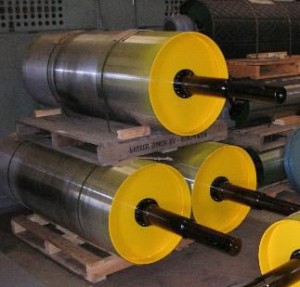The Significance of Bearing Housings in Conveyor Pulleys
October 28th, 2015 Speed and load calculations define the theoretical limits of conveyor systems. Rollers use these figures, converting radial motion into belt-driven linear momentum. In an ideal world this efficient transfer of energy would drive pulleys, the roller would push the conveyor belt, and the system would mesh to effortlessly deliver heavy loads. Of course, conditions are rarely if ever ideal. The mining industry, for example, fills the air with dust. Quarrying operations face the same issues, although its fine clouds of coarse granite that coat surfaces in this instance. Layers of toughened materials, cladding and premium metal alloys, battle the bulk of these machine-degrading elements, which leaves bearing housings in conveyor pulleys the role of ejecting contaminants before they can reach the moving heart of the mechanism.
Speed and load calculations define the theoretical limits of conveyor systems. Rollers use these figures, converting radial motion into belt-driven linear momentum. In an ideal world this efficient transfer of energy would drive pulleys, the roller would push the conveyor belt, and the system would mesh to effortlessly deliver heavy loads. Of course, conditions are rarely if ever ideal. The mining industry, for example, fills the air with dust. Quarrying operations face the same issues, although its fine clouds of coarse granite that coat surfaces in this instance. Layers of toughened materials, cladding and premium metal alloys, battle the bulk of these machine-degrading elements, which leaves bearing housings in conveyor pulleys the role of ejecting contaminants before they can reach the moving heart of the mechanism.
Bearing Housings in Conveyor Pulleys Support Energy Transmission
Bearing housings are engineered to contain a variety of differing innards, workings that drive pulleys smoothly. They’re forged from metal and built to cradle fine bearings. The housing contains friction-eliminating components, stationary circular rails and fast-moving rings that are keyed to the shafts of system-essential pulleys. Lubrication is a primary concern in this environment, as is the conduction of latent heat away from the hot bearings. It’s inside this casing, after all, that dynamic motion and the anchoring of stationary components combine precisely like a lock and key, although, at least in this specialist case, the key is a rotating shaft. The housing channels lubrication to the bearing and balances this act by moving heat away from the moving parts.
Bearing Housings are Key in Sealing Virgin Territory
Machine housings are notable for their adjustable builds, for being able to compensate for the day-to-day influences of rocky matter moving at speed. As compelling a feature as a calibration mechanism is, we’re still missing the biggest talent of the enclosure. Bearing enclosures are indeed designed to aid in heat reduction and keep a lubricant just where it’s required, but the primary skill of the enclosure comes from its contaminant shielding aptitude. Remember, this isn’t an ideal application for a shaft and its associated bearings. The ideal situation would be a dust-free environment and a zero-friction lubricant that possesses pure chemical compounds. Unfortunately, this is a dirty mine, a gritty quarry, or even a carbon-choked power station. The housing has to fit a profile that matches a moving shaft but still seal the innards from the dusty matter bumping along the conveyor belt.
Auxiliary mechanisms are often built into bearing housings, and these supplemental parts are designed to use centrifugal force to “spin out” moisture and dust, but the best resolution here is still to employ a seal, one that favours maintenance but is pure-bred to provide an inviolable physical barrier.
CONVEYOR PULLEYS RUBBERFIX PTY LTD
6A Kempson Court, Keysborough,
VIC Australia, 3173
6A Kempson Court, Keysborough,
VIC Australia, 3173
Phone: + 61 3 9769 0777
Fax: + 61 3 9706 3834
VoIP: + 61 3 8743 3167
Mob: 0402 307 817
Email: rubberfix@iinet.net.au
www.cprpulleys.com.au
Optimized by NetwizardSEO.com.au
